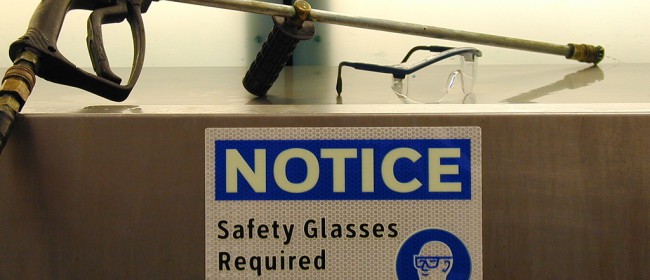Many insurance claims we see in the AICC program are unfortunately the result of eye and face injuries that could have been prevented with proper Personal Protective Equipment (PPE). Read on to learn how important and easy it is to implement proper eye and face protection in the workplace.
Personal Protective Equipment Selection
Before assigning to workers Personal Protective Equipment (PPE), management should assess the workplace for hazards. A hazard assessment should determine the risk of eye and face injuries, including injuries from hazards that may be encountered in an emergency. Employers should consider the possibility of multiple and simultaneous hazard exposures, and be prepared to protect against the highest level of each hazard.
Hazards To Assess:
- Impact
- Heat
- Chemicals
- Dust
- Optical Radiation
Personal Protective Equipment for Impact
While working in a hazardous area where the worker is exposed to flying objects, fragments, and particles, primary protective devices such as safety spectacles with side shields or goggles must be worn. Secondary protective devices such as face shields are required in conjunction with primary protective devices during severe exposure to impact hazards.
PPE Devices for Impact Hazards
- Spectacles: Primary protectors intended to shield the eyes from a variety of impact hazards.
- Goggles: Primary protectors intended to shield the eyes against flying fragments, objects, large chips, and particles.
- Face Shields: Secondary protectors intended to protect the entire face against exposure to impact hazards.
Personal Protective Equipment for Heat
Heat injuries may occur to the eye and face when workers are exposed to high temperatures, splashes of molten metal, or hot sparks. Protect your eyes from heat when workplace operations involve pouring, casting, hot dipping, furnace operations, and other similar activities. Burns to eye and face tissue are the main concern when working with heat hazards. Working with heat hazards requires eye protection such as goggles or safety spectacles with special-purpose lenses and side shields. However, many heat hazard exposures require the use of a face shield in addition to safety spectacles or goggles. When selecting PPE, consider the source and intensity of the heat and the type of splashes that may occur in the workplace.
PPE Devices for Heat Hazards
- Spectacles: Primary protectors intended to shield the eyes from a variety of heat hazards.
- Goggles: Primary protectors intended to shield the eyes against a variety of heat hazards.
- Face Shields: Secondary protectors intended to shield the entire face against exposure to high temperatures, splash from molten metal, and hot sparks.
Personal Protective Equipment for Chemicals
A large percentage of eye injuries are caused by direct contact with chemicals. These injuries often result from an inappropriate choice of PPE that allows a chemical substance to enter from around or under protective eye equipment. Serious and irreversible damage can occur when chemical substances contact the eyes in the form of splash, mists, vapors, or fumes. When working with or around chemicals, it is important to know the location of emergency eyewash stations and how to access them with restricted vision. When fitted and worn correctly, goggles protect your eyes from hazardous substances. A face shield may be required in areas where workers are exposed to severe chemical hazards.
PPE Devices for Chemical Hazards
- Goggles: Primary protectors intended to shield the eyes against liquid or chemical splash, irritating mists, vapors, and fumes.
- Face Shields: Secondary protectors intended to protect the entire face against exposure to chemical hazards.
Personal Protective Equipment for Optical Radiation / Welding
The intensity of visible light and radiant energy produced by welding operations varies depending on the task, the electrode size, and the arc current. Workers involved in welding, cutting, and brazing operations must use appropriate welding protection depending on specific welding operations. Only filter lenses with the appropriate shade number will provide protection against optical radiation. Filter lenses must coincide to specific radiant energy exposure. These devices protect the eyes and face from flying sparks, metal spatter, and slag chips produced during welding, brazing, soldering, and cutting. Welding helmets are secondary protectors intended to shield the eyes and face from optical radiation, heat, and impact. Use welding helmets in addition to primary protection such as safety spectacles or goggles to provide adequate protection.
PPE Devices for Optical Radiation / Welding
- Goggles: Primary protectors intended to shield the eyes against optical radiation.
- Face Shields: Primary protectors intended to shield the eyes against UV radiation hazards, but be sure they have proper filter strength.
- Welding Helmets: Secondary protectors intended to protect the entire face against exposure to UV rays.
Check out the Awane Safety Tips section of our blog for more helpful information on workplace safety.
Image courtesy of Flickr user SmartSignBrooklyn
Recent Posts
IRS Guidance on Nutrition, Wellness, and General Health Expenses
The Internal Revenue Service (IRS) has recently highlighted that costs associated with nutrition, wellness, and general health do not typically qualify as reimbursable medical expenses [...]
HSAs Today and Every Day: A Triple Threat Against Rising Healthcare Costs
The healthcare landscape is constantly evolving, and in 2024, rising costs remain a top concern for both employers and employees. Fortunately, Health Savings Accounts (HSAs) [...]
April Showers Don’t Cause Accidents (Distracted Driving Does): Stay Safe on the Road This Month (and Every Month)
Spring is here, and with it comes April's designation as Distracted Driving Awareness Month. While the changing seasons and blooming flowers might tempt you to [...]




